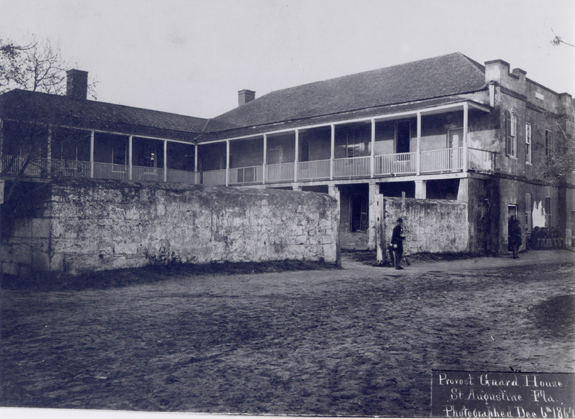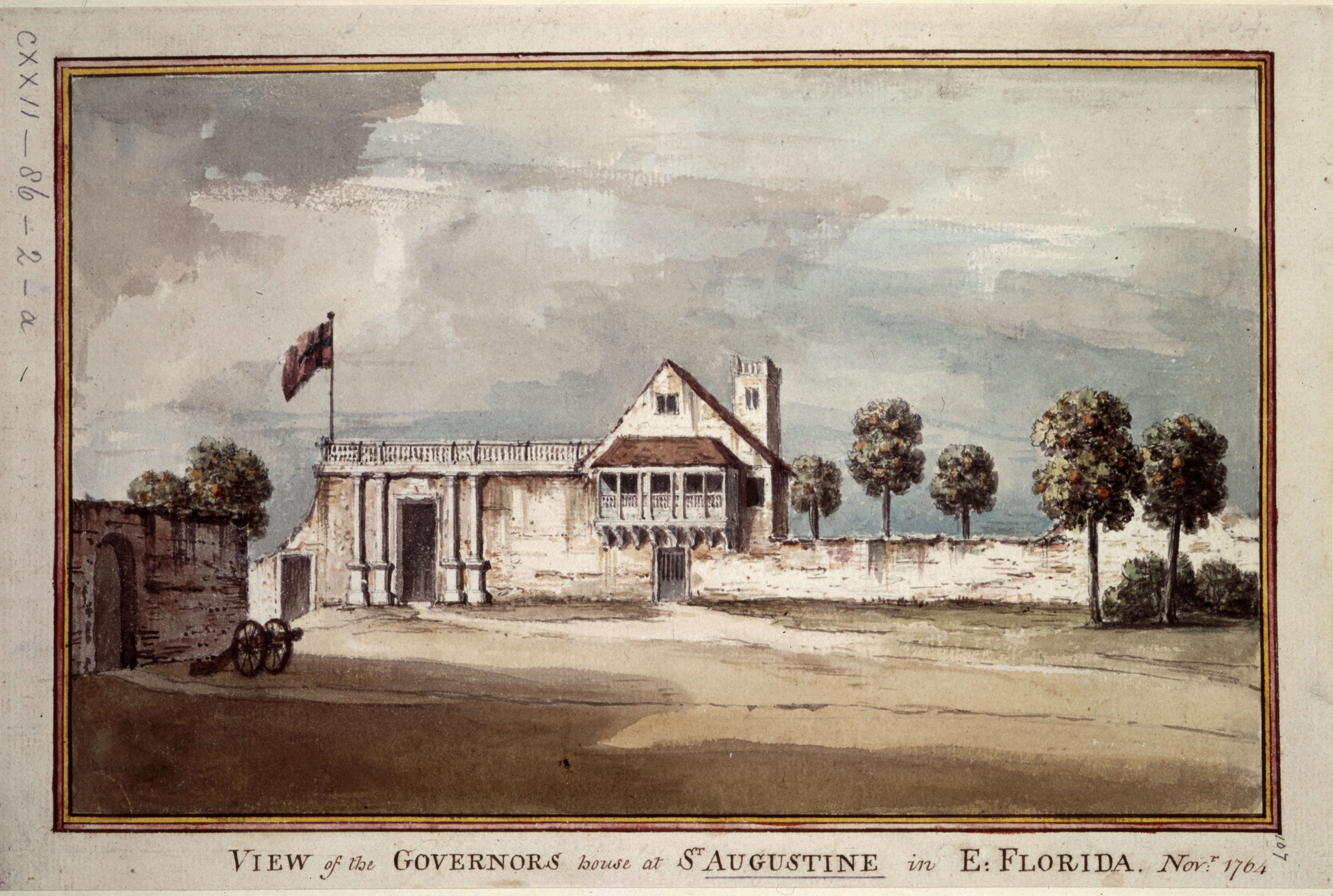Governor's House Cultural Center and Museum History
By Janet Snyder Matthews Ph.D.
Government House dominates the west end of the Town Plaza, a unique Spanish land use component lying within a National Historic Landmark District. [i] Spain's 1573 Law of the Indies, Leyes de los Indies, specified that colonial town plans set aside such a plaza for government, church and public use. Along coasts, plazas were to begin at the waterfront - to see and to be seen. Since 1598, a government building has stood on this site with a view of the harbor landing, accommodating administrative headquarters and residences of colonial governors appointed by the Crowns of Spain, then Britain, then Spain again. [ii] After Spain ceded Florida to the United States in 1821, this current Government House served as a courthouse and briefly as a Capitol of the new Territory of Florida. In 1836, the building's crenellated five-story tower and "a Grand portico decorated with dorick Pillars and Entablature" were removed by Robert Mills, famed architect of the Washington Monument. [iii]
In 1937,the Works Progress Administration remodeled the courthouse as "United States Post Office & Customs House." The 1935 architectural plans depict "old coquina stone walls" which may date to St. Augustine's first Spanish colonial period.[iv] Outlines of windows and exposed coquina limestone of those old walls are visible on today's north, east, and south facades. The new concrete-encased steel-frame wing flanked a walled courtyard on the east, a driveway to loading docks on the west. A central two-story work room was viewed from a second-story "lookout." Separate clerks and carrier "swing rooms" and separate toilets were accessed by separate stairs. Offices of the U.S. Department of Agriculture, Agriculture Extension Service and Postal Inspector lined a separate oak-floored hallway with marble-paneled toilets for men and women. In the old building, a marble-paneled corridor led into stately high-ceilinged offices of the Civil Service Commission, Public Health, and Customs, which opened onto a shaded gallery over the courtyard. [v]
In 1959, Governor Leroy Collins signed into law Chapter 59-521, establishing the St. Augustine Historical Restoration and Preservation Commission. The Bill's sponsor in the Senate was Verle Pope, "The Lion of St. Johns," whose home stood near the foot of the Bridge of Lions. The Act authorized the Commission to hire professionals to direct research, acquire, reconstruct, restore, and preserve with funds appropriated by the State. It also provided for demolition and clearance of buildings within defined "slum areas." [vi] Governor Collins appointed five Commissioners whose meetings and staff and a growing archeological collection were headquartered in Government House. After disastrous floodwater damage to the collection, a 1989 State grant funded accession, curation and cataloging of 980 boxes by the University of Florida Museum of Natural History, a process requiring continuous work for more than two decades. [vii]
Government House is one of the state-owned buildings managed by the University of Florida "to ensure long-term preservation and interpretation of state-owned historic properties in St. Augustine while facilitating an educational program at the University of Florida... responsive to the state's needs for professionals in historic preservation, archaeology, cultural resource management, cultural tourism, and museum administration and will help meet needs of St. Augustine and the state through educational internships and practicums." [viii]
Footnotes
[i] Gordon, Elsbeth K., Florida’s Colonial Architectural Heritage, 2003; Roy Hunt to author, December 2, 2010.
[ii] Ibid., Gordon and Gordon by phone to author, November 30, 2010.
[iii] Gordon, 2010 Manuscript, Chapter 9, quoting William Gerard DeBrahm, Britain’s 1st Surveyor General of Colonial East Florida, and resident of St. Augustine from “The History of Three Provinces, South Carolina, Georgia & East Florida” 290, Photostat copy at St. Augustine Historical Society Research Library, Florida history, 1767, DeBrahm Material. During the Spanish colonial periods, referred to as Casa de Govierno, Casa del Governador or Casa de la Governadora, Susan R. Parker to author December 2, 2010.
[iv] “Extension and Remodelling”, Treasury Department United States Post Office & Customs House, St. Augustine Florida Mellon C Greeley FAIA, Architect, Jacksonville, May 20, signed July 20-21, 1935, Sheet # G 1. On file, University of Florida Library; Review of Sheet G 1 with Herschel Shepard, FAIA, and Linda Dixon, AICP, at Government House, November 22, 2010.
[v] Assignment of Post Office & Custom House, Second Floor Plan [office space], Drawn by K.Y. Saint, December 16, 1935, Drawing Number AS-4. On file, University of Florida Library. Review of Drawing AS-4 with Linda Dixon, AICP, at Government House, November 29, 2010.
[vi] House Bill 774 (1959); Senate Bill 381 (1959); Chapter 59-521 Laws of Florida, pp. 1758-1762; In the same legislative session, Pope’s close ally, first-term Senator Ed. H. Price Jr. of Bradenton, sponsored a bill for the Florida School for the Deaf and the Blind - of which both Pope’s parents were Alumni. Price routinely visited with the Popes at home, roomed together in Tallahassee, and visited the FSDB where Pope “signed” speeches to student assemblies. Ed. H. Price Jr. to author by phone, November 25, 2010 and Governor Bob Graham’s Oral History program on Verle Pope, Price Remarks at Governor’s Mansion dinner, 1980.
[vii] Dr. Kathleen A. Deagan, collection meeting with DCP 6711 students, Florida Museum of Natural History, November 23, 2010; Deagan by phone to author, December 1, 2010.
[viii] Chapter 267.1735, Laws of Florida, Access:http://www.flsenate.gov/Statutes/index.cfm?App_mode=Display_Statute&Search_String=&URL=Ch0267/SEC1735.HTM
Historic Photos
 Photographer: Samuel A. Cooley, Union Army photographer, 1864, Library of Congress. Courtesy, St. Augustine Historical Society.
Photographer: Samuel A. Cooley, Union Army photographer, 1864, Library of Congress. Courtesy, St. Augustine Historical Society.

Gordon, Lord Adam. VIEW of the GOVERNOR'S house at ST. AUGUSTINE in E. FLORIDA. 1764. Watercolor. British Library, London.